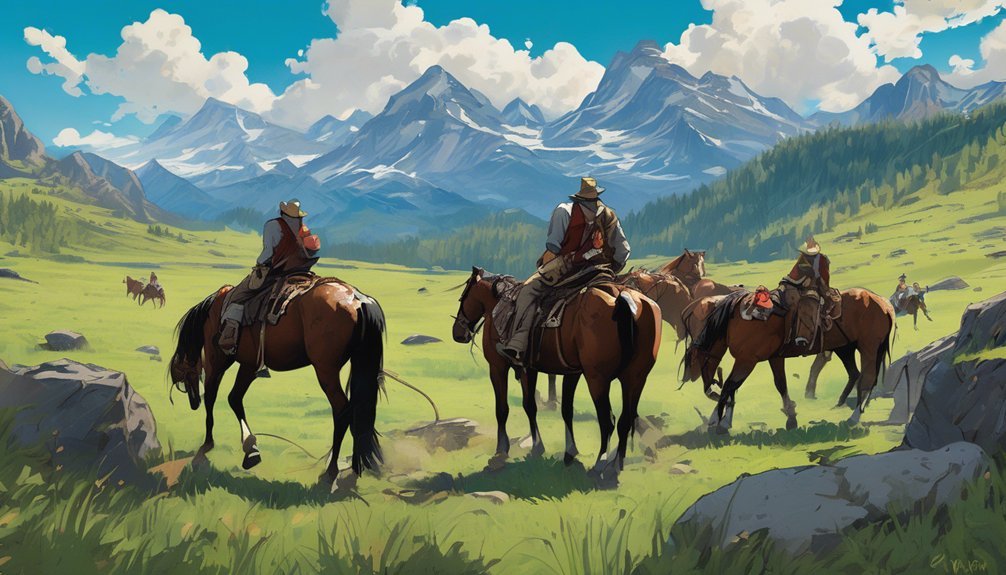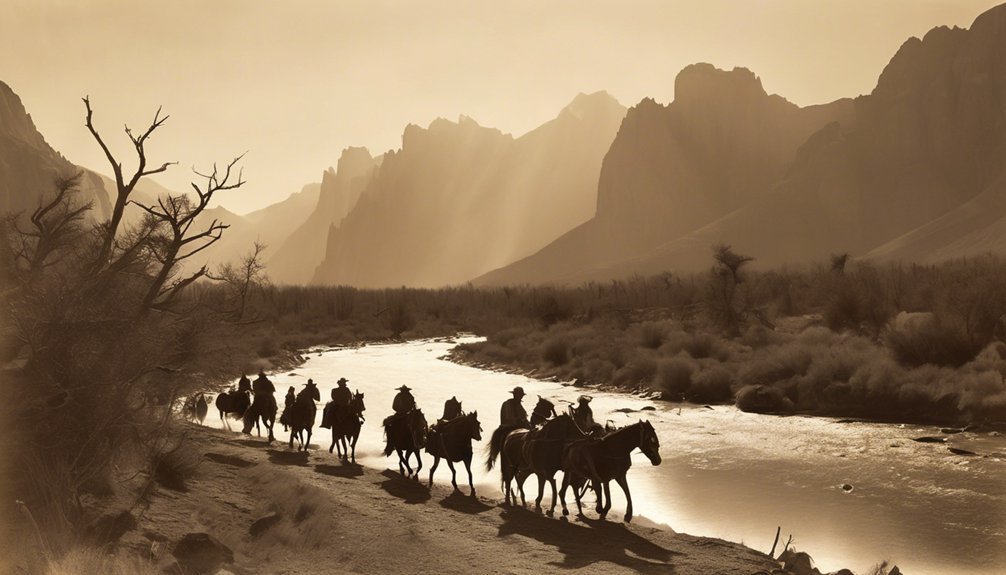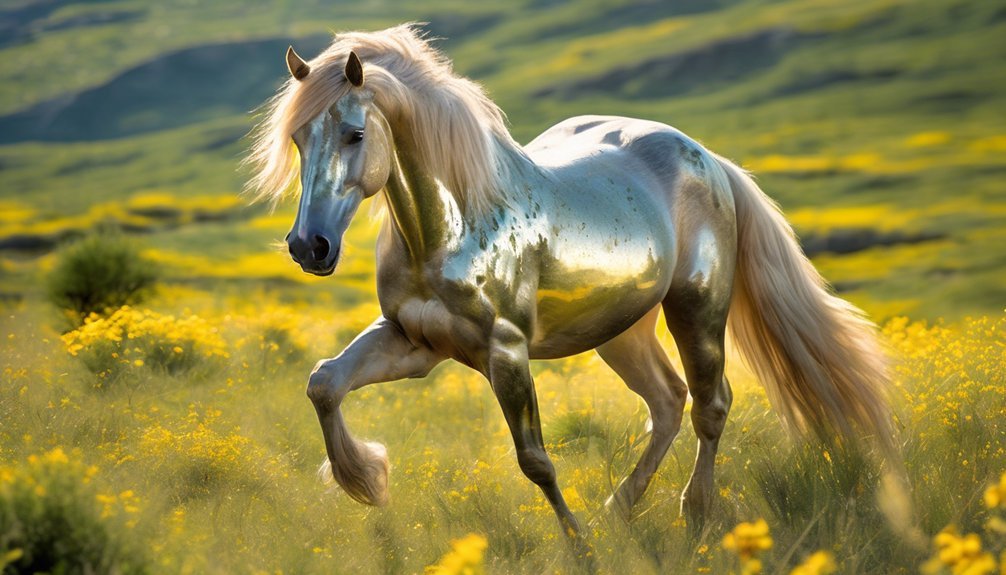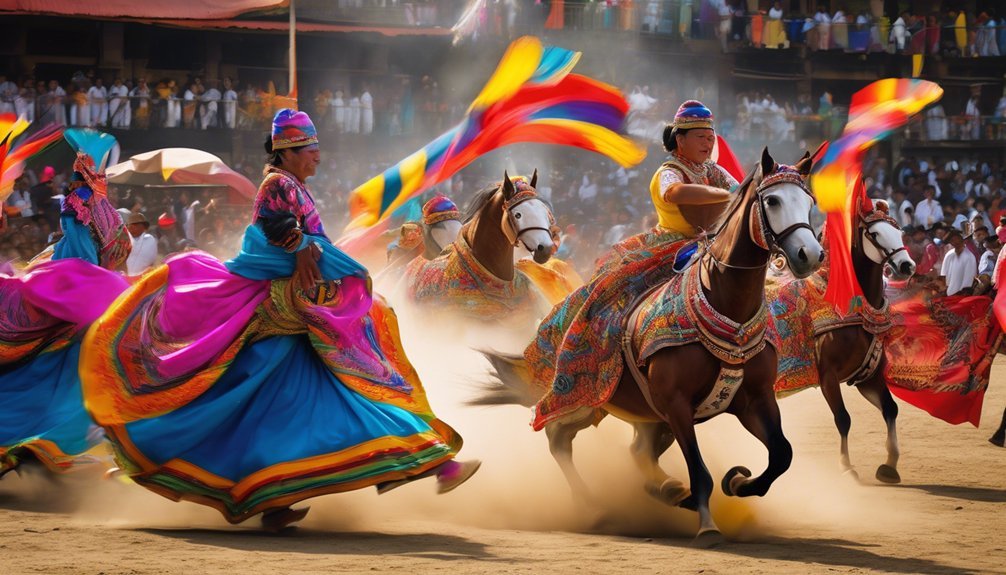
Pack horses are the unsung heroes of exploration, their sturdy forms navigating the wild like shadows in the wilderness. These animals have not only carried physical burdens but also played pivotal roles in shaping historical narratives. From the treacherous trails of the Gold Rush to the uncharted territories of the Lewis and Clark Expedition, their contributions are often overlooked. What can these steadfast companions reveal about the intricate relationship between humans and nature during pivotal explorations?
Key Takeaways
- Pack horses were crucial for transporting goods and supplies, facilitating trade and exploration during historical expeditions.
- They played significant roles in iconic explorations, such as the Lewis and Clark Expedition and the 1800s Gold Rush.
- Indigenous communities view pack horses as symbols of cultural significance, enhancing community ties and spiritual connections.
- Modern uses of pack horses in rugged terrains contribute to eco-friendly tourism and wilderness therapy experiences.
- In literature and cinema, pack horses symbolize resilience, loyalty, and the importance of companionship in overcoming challenges during adventures.
The Origins of Pack Horses in Human History

As humans began to explore and settle various terrains, they quickly recognized the value of pack horses for transporting goods and supplies.
In the context of ancient transportation, the domestication of equines marked a significant shift, allowing communities to traverse vast distances efficiently. Early humans saw that horses could carry heavy loads, which made them indispensable in trade and exploration.
This relationship evolved as people selectively bred equines for strength and endurance, leading to the emergence of specialized pack horses. The ability to transport agricultural products, tools, and personal belongings transformed how societies interacted, expanded their reach, and ultimately shaped cultural exchanges.
Thus, pack horses became vital allies in humanity's journey through diverse landscapes and challenges.
The Anatomy and Characteristics of an Ideal Pack Horse
Understanding how pack horses have been utilized in exploration leads to an examination of the specific anatomical and behavioral traits that make an ideal pack horse.
The ideal characteristics of a pack horse are crucial for ensuring successful journeys. Here are some key traits to consider:
- Sturdy Build: A strong, muscular frame supports heavy loads.
- Surefootedness: Excellent balance and agility help navigate rough terrain.
- Calm Temperament: A docile nature ensures reliability in stressful situations.
- Endurance: Stamina is essential for long treks over varied landscapes.
These elements of pack horse anatomy combine to create a dependable companion in exploration, allowing you to focus on the adventure ahead while trusting your horse's abilities.
Iconic Explorations Featuring Pack Horses
Pack horses have played a pivotal role in numerous iconic explorations throughout history, demonstrating their value as reliable partners in the face of challenging environments.
During famous expeditions such as the 1800s gold rush, these sturdy animals traversed legendary trails, carrying essential supplies and equipment. In the rugged terrains of the Rocky Mountains, pack horses enabled explorers to navigate harsh landscapes while ensuring their survival.
The Lewis and Clark Expedition also relied heavily on these dependable creatures, showcasing their adaptability and strength. Each journey not only underscored the importance of pack horses but also highlighted the bond formed between humans and animals in pursuit of adventure.
Their contributions remain a testament to the spirit of exploration and resilience.
The Role of Pack Horses in the Lewis and Clark Expedition

During the Lewis and Clark Expedition, pack horses proved indispensable for the success of the journey.
These sturdy animals facilitated pack transportation, enabling the team to navigate vast, rugged landscapes. The expedition's logistics relied heavily on the horses, which carried essential supplies and equipment.
Key factors influencing their role included:
- Efficient load distribution to maintain balance
- Sustainable horse welfare to ensure endurance
- Strategic route planning to minimize fatigue
- Regular rest periods to optimize performance
Pack Horses in the Gold Rush Era
As thousands of prospectors flocked to the West in search of fortune during the Gold Rush era, pack horses became vital allies in their quest.
These sturdy animals efficiently navigated the challenging terrain, essential for gold rush logistics. You'd often find breeds like the sure-footed Mongolian, reliable Surefoot, or the hardy Appaloosa, chosen for their endurance and temperament.
Each pack horse could carry up to 200 pounds, allowing for transportation of tools, food, and personal items crucial for survival. Their ability to traverse steep mountains and rocky paths made them indispensable, enabling prospectors to focus on their search for gold without the burden of heavy loads.
In this way, pack horses shaped the very fabric of the Gold Rush experience.
Cultural Significance of Pack Horses in Indigenous Communities
While many might associate horses primarily with transportation, in Indigenous communities, pack horses hold a deeper cultural significance that transcends mere utility.
These majestic animals symbolize much more than just a means of carrying goods; they embody essential aspects of life and community.
- Cultural practices involving horses strengthen ties among community members.
- Indigenous traditions often incorporate horses in ceremonies and rituals, enhancing spiritual connections.
- Pack horse symbolism reflects resilience, adaptability, and the bond between humans and nature.
- Community bonding occurs as members share responsibilities related to horse care and training.
Understanding this significance allows you to appreciate how pack horses foster identity and connection within Indigenous societies, highlighting their integral role beyond physical labor.
Modern Uses of Pack Horses in Exploration and Outdoor Activities

Pack horses play a crucial role in modern exploration and outdoor activities, particularly in rugged terrains where traditional vehicles struggle to navigate. They enhance sustainable tourism by providing eco-friendly transportation options that minimize environmental impact. In wilderness therapy, pack horses offer a unique connection to nature, allowing participants to engage in healing experiences while exploring remote areas.
| Aspect | Benefits |
|---|---|
| Sustainable Tourism | Eco-friendly transport |
| Wilderness Therapy | Connection to nature |
| Accessibility | Reach remote locations |
| Adventure | Unique outdoor experiences |
Utilizing pack horses fosters a sense of intimacy with the landscape, creating unforgettable memories that resonate deeply with adventurers and nature enthusiasts alike.
Training and Care of Pack Horses for Exploration
Effective training and care of pack horses are essential for ensuring their reliability and well-being during exploration. By focusing on several key aspects, you can prepare your pack horse for the demands of the trail:
- Saddle fitting: Ensure the saddle fits properly to prevent discomfort and injuries.
- Feeding schedules: Maintain a consistent feeding routine to keep energy levels stable.
- Grooming techniques: Regular grooming helps with hygiene and builds trust between you and the horse.
- Trail training: Gradually expose your horse to various terrains and conditions for better endurance building.
Additionally, monitor pack weight carefully, practice hoof care diligently, and employ effective behavior management strategies.
These elements together create a strong foundation for a successful exploration experience with your pack horse.
The Legacy of Pack Horses in Adventure Literature and Media
Pack horses serve as iconic literary companions, symbolizing loyalty and resilience in adventure narratives.
In film and literature, they often embody the spirit of exploration, enhancing the journey's emotional depth and realism. Their representation highlights broader themes of companionship and the burdens one carries, making them integral to the storytelling of exploration.
Iconic Literary Companions
While many adventure stories focus on heroic protagonists and their daring exploits, the presence of pack horses often serves as a silent yet vital thread woven into the narrative.
These literary companions embody not just utility but also rich symbolism, enhancing the protagonists' journeys.
Consider how pack horses:
- Represent unwavering loyalty amidst challenges.
- Act as symbols of the burdens carried in one's quest.
- Provide moments of reflection and connection to nature.
- Serve as essential players in the unfolding of adventure.
In literature, pack horses symbolize journeys that are both physical and emotional, enriching the tales they inhabit.
Their roles remind us that every adventure involves not just the hero, but the steadfast companions that make the journey possible.
Cinematic Representations of Adventure
Adventure narratives have long celebrated not only the heroes but also the companions that accompany them, and pack horses have found their way into the cinematic portrayal of these epic journeys.
In films, pack horses symbolize resilience and loyalty, embodying the spirit of exploration. Their presence in cinematic adventures often underscores the bond between humans and animals, offering a deeper emotional connection to the characters' struggles.
These equine companions, laden with supplies, become vital players in the narrative, showcasing not just their physical strength but also their unwavering support.
As you watch these films, you can appreciate how pack horses elevate the adventure, highlighting themes of teamwork and perseverance against nature's grandeur.
Their legacy remains woven into the tapestry of cinematic storytelling.
Symbolism in Exploration Journeys
Throughout exploration journeys in literature and media, pack horses symbolize the steadfast support and essential role of companionship in overcoming daunting challenges.
These noble creatures serve as a powerful metaphor for the interconnectedness of human experiences during metaphorical journeys. They embody the companionship symbolism that resonates deeply within adventure narratives.
Consider the following aspects:
- Reliability: Pack horses are always there, carrying burdens alongside explorers.
- Resilience: They exhibit endurance, mirroring the human spirit in adversity.
- Connection: Their presence fosters bonds among adventurers and the natural world.
- Legacy: They remind us of the importance of support systems in our quests.
Ultimately, pack horses remind us that the journey is often as significant as the destination, highlighting our need for companionship through life's challenges.
Frequently Asked Questions
What Breeds Are Commonly Used as Pack Horses Today?
When considering pack horse breeds, you'll often encounter sturdy options like the Morgan, Quarter Horse, and Haflinger. Each requires specific training methods to ensure they can effectively carry loads and navigate diverse terrains with confidence.
How Do Pack Horses Communicate With Their Handlers?
You might think pack horses only rely on vocalizations, but they also use body language to communicate with you. Signals like ear positioning or tail movements reveal their comfort levels and readiness, deepening your connection.
What Are the Ethical Considerations in Using Pack Horses?
When using pack horses, you must consider animal welfare and sustainable practices. Ensuring their health and comfort is essential, as is minimizing environmental impact. Balancing these factors fosters a responsible relationship between you and these hardworking animals.
How Are Pack Horses Selected for Specific Terrains?
Selecting pack horses for specific terrains isn't just a science; it's an art. You'll assess their terrain adaptability and physical attributes, ensuring they're agile, strong, and resilient enough to tackle challenging landscapes effortlessly.
What Are Common Health Issues Faced by Pack Horses?
You'll find common health issues in pack horses include dental problems and hoof deterioration. Regular dental care ensures proper chewing, while consistent hoof maintenance prevents injuries, ensuring your horse remains healthy and capable for demanding terrains.
Conclusion
In exploring the profound impact of pack horses, you recognize their undeniable importance in shaping human adventures. These resilient companions not only carried supplies across treacherous landscapes but also forged lasting bonds with their handlers. Their legacy echoes through history, revealing how they transformed exploration into a shared journey. As pack horses continue to play a vital role in modern outdoor pursuits, their story remains a testament to the extraordinary partnership between humans and animals, forever etched in our collective memory.





